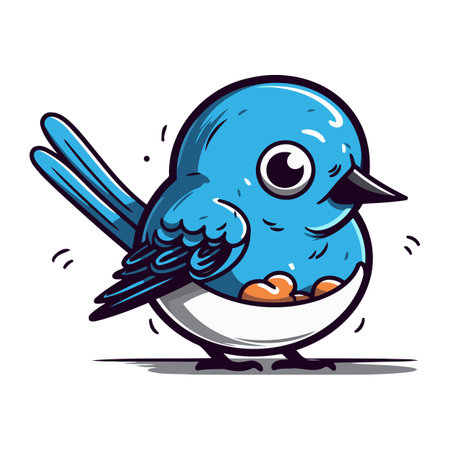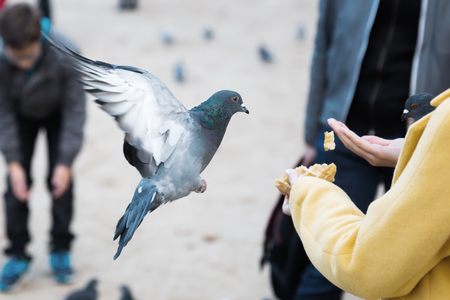Introduction to Companion Bird Behaviour
Keeping companion birds is an increasingly popular choice among UK pet owners, with species like budgerigars, cockatiels, African greys, and lovebirds gracing homes across the country. Understanding the basics of their behaviour is essential for ensuring a happy and healthy relationship with your feathered friend. Birds are intelligent creatures with unique personalities and distinct ways of communicating their needs and emotions. By observing their actions, vocalisations, and body language, owners can gain valuable insights into what their pets are feeling or trying to express. Whether you’re a first-time bird owner or have years of experience, familiarising yourself with common behaviours seen in the UK’s favourite pet birds is the first step towards building trust and creating a harmonious environment at home.
2. Recognising Signs of Happiness and Stress
Understanding your companion bird’s emotional state is essential for their wellbeing, especially within the unique context of a UK home. Birds are highly expressive creatures, but their signals can be subtle and easy to overlook if you’re not familiar with avian body language. By learning to spot both positive and negative behaviours, you’ll be better equipped to provide a comfortable and enriching environment for your feathered friend.
Key Behavioural Cues in Pet Birds
Birds express happiness and stress in various ways. Here’s a helpful table summarising common behaviours and what they typically indicate:
| Behaviour | Indicates Happiness | Indicates Stress |
|---|---|---|
| Fluffed feathers & relaxed posture | Yes – content and comfortable | No – unless combined with lethargy |
| Singing, chattering or mimicking sounds | Yes – feeling secure and stimulated | No |
| Pacing or repetitive movements | No | Yes – possibly anxious or bored |
| Biting cage bars or plucking feathers | No | Yes – often due to stress or lack of stimulation |
| Preening in your presence | Yes – trusts you and feels safe | No |
| Screaming or excessive vocalisation | No (unless it’s a normal morning/evening routine) | Yes – may signal distress or demand for attention |
| Tucked head, closed eyes while perched | Yes – relaxed and possibly sleepy during quiet times | No (unless lethargic at unusual hours) |
The Influence of UK Home Environments on Bird Behaviour
Many British homes have particular features—such as central heating, variable daylight hours, and smaller garden spaces—that can impact your bird’s mood and behaviour. For example, prolonged darkness during winter months might cause some birds to become less active or even mimic seasonal affective disorder. Conversely, the hustle and bustle of family life, especially in terraced houses with thin walls, could lead to overstimulation or stress if your bird cannot find a quiet retreat.
Tips for Monitoring Emotional Wellbeing in Your Bird:
- Observe daily routines: Changes in sleeping, eating, or vocal habits often signal shifts in emotional health.
- Create consistent light cycles: Use timers for lamps during dark winters to mimic natural daylight patterns.
- Provide enrichment: Rotate toys and offer safe branches from local trees (avoiding toxic species) for variety.
- Ensure quiet spaces: Set up a ‘rest corner’ away from TVs or high-traffic areas so your bird has somewhere peaceful to retreat.
- Avoid draughts: Many UK homes can be chilly; ensure your bird’s cage is away from windows or doors that let in cold air.
By understanding these signs and making thoughtful adjustments based on UK living conditions, you’ll help ensure your companion bird remains happy and healthy year-round.

3. Communication: Vocalisations and Body Language
Understanding your companion bird’s methods of communication is essential for building a strong bond and ensuring their wellbeing. Birds in the UK are known for their rich variety of vocalisations and expressive body language, which can sometimes puzzle even experienced owners. From cheerful chirps to emphatic squawks, each sound holds meaning. For example, a content budgie may produce soft warbles or whistles, often heard during the quiet hours of a British afternoon. In contrast, loud squawking or screeching, especially if sudden, may indicate distress or boredom—perhaps your parrot is missing interaction while you’re out for a stroll down the High Street.
Body language offers further clues. A relaxed bird might fluff up its feathers slightly or preen, particularly after a rain shower when the British weather turns damp. On the other hand, pinning eyes (where the pupils rapidly contract and dilate), raised head feathers, or a rigid stance can signal excitement or agitation—something to be mindful of when introducing your pet to new visitors during a Sunday roast. Tail fanning or wing stretching are signs of confidence and comfort, whereas crouching low with tightly held feathers could suggest fear or submission.
Feather displays also have distinct meanings. A cockatiel crest raised high points to curiosity or alarm—a common sight if your feathered friend spots a magpie through the window. Ruffled feathers combined with head bobbing may indicate that your bird wants attention or playtime, reminiscent of the lively atmosphere in local parks. By observing these cues within your home environment, you’ll be better equipped to respond appropriately, fostering trust and harmony in your shared daily life.
4. Creating a Bird-Friendly Home
Designing a home that caters to your companion bird’s needs is essential for their well-being, especially considering the typical UK climate and housing styles. Birds are highly intelligent and active creatures that require mental stimulation, safe spaces, and suitable environmental conditions. Below are practical tips for UK bird owners looking to enrich their feathered friends’ living spaces.
Enrichment Essentials for UK Homes
Whether you live in a terraced house, a flat in London, or a countryside cottage, certain essentials can transform your space into a bird haven:
- Cage Placement: Choose a draught-free area away from radiators and direct sunlight. British weather can be unpredictable, so avoid placing cages near windows with cold drafts or condensation.
- Natural Light: Birds thrive on natural light but not direct sun exposure. Consider positioning the cage where your bird can enjoy gentle daylight but also retreat to shaded areas.
- Toys & Foraging Activities: Rotate toys regularly and include puzzle feeders. Use safe UK-sourced branches (like apple or willow) for perches to mimic natural environments.
- Social Interaction: Birds are social animals. Place their cage in rooms where family activity happens, but ensure they have quiet time too.
Adapting to the UK Climate
The UK’s cool and damp climate requires some extra considerations for avian health:
| Climate Challenge | Solution |
|---|---|
| Dampness & Mould | Use dehumidifiers and regularly check for mould around the cage area. |
| Low Winter Temperatures | Avoid placing cages near doors or windows. Provide thermal covers at night but ensure ventilation. |
| Lack of Sunlight | Consider full-spectrum UV lamps designed for birds during darker months, especially if outdoor access is limited. |
Housing Types: Tailored Suggestions
- Flats/Apartments: Opt for compact cages with vertical climbing space. Use soundproofing if neighbours are close by.
- Terraced/Semi-Detached Homes: Utilise under-stair nooks or alcoves as bird play zones. Keep birds away from kitchens due to fumes from non-stick cookware.
- Cottages/Detached Houses: If you have more space, create a dedicated bird room or indoor aviary with plenty of flying room and enrichment stations.
Quick Tips for a Happy Bird Home
- Maintain consistent daily routines—UK birds benefit from regular feeding and playtimes.
- Add safe greenery like potted herbs (basil, parsley) for nibbling and environmental enrichment.
- Avoid scented candles, aerosols, and tobacco smoke indoors as these can harm birds’ sensitive respiratory systems.
Your UK bird will flourish with a well-considered set-up that reflects both their natural instincts and the unique features of your home environment!
5. Socialisation and Handling
Building a strong bond with your companion bird is essential for a happy and well-adjusted pet, especially within the unique lifestyle rhythms of UK households. Socialisation starts with patience, gentle handling, and an understanding of your bird’s comfort zones. For British owners, who may often balance work-from-home routines or traditional 9-to-5 schedules, it’s important to set aside consistent time each day for interaction. Birds thrive on routine; try greeting your feathered friend in the morning before heading out, or having a little playtime during tea breaks or after supper.
Use positive reinforcement techniques, such as offering favourite treats like millet sprays or fresh fruit slices when your bird steps onto your hand or interacts calmly. Always approach your bird slowly and speak softly—abrupt movements or loud voices can startle even the bravest parrot or budgie. Involve all household members in socialisation to encourage your bird to feel comfortable with everyone, reflecting the sociable nature of many British homes.
When it comes to handling, remember that birds need to feel secure. Allow them to perch on your finger rather than being grabbed, and never force interaction if they seem stressed. For those living in flats or urban areas common across the UK, utilise flight-safe rooms where your bird can stretch its wings under supervision. Enrichment is key: rotate toys regularly and introduce puzzle feeders to keep their minds active during those quieter afternoons when you’re at work or out running errands.
Finally, consider incorporating some uniquely British experiences into your routine—perhaps letting your bird observe garden birds from the window, or including them (safely) during family gatherings like Sunday roasts or holiday celebrations. With mindful socialisation and gentle handling tailored to UK lifestyles, you’ll nurture a confident, affectionate companion who feels truly at home.
6. Preventing and Managing Unwanted Behaviours
Every companion bird can develop unwanted behaviours from time to time, whether it’s feather plucking, excessive noise, or destructive chewing. Fortunately, there are practical strategies UK bird owners can implement to create a harmonious home environment and support their feathered friends.
Understanding the Root Causes
Begin by observing your bird’s routine and environment. Many behavioural issues stem from boredom, lack of stimulation, or changes in the household. Feather plucking, for example, can often be a sign of stress or medical problems—so it’s wise to consult an avian vet if you notice this behaviour. Excessive squawking may indicate your bird is seeking attention or feeling isolated.
Enrichment and Stimulation
British homes can sometimes be quieter or more compact, so ensuring your bird has plenty of engaging toys, perches, and activities is essential. Rotate toys regularly to keep things fresh and encourage natural foraging by hiding treats in safe puzzle feeders. Even placing your bird’s cage near a window (avoiding draughts) allows them to watch the world go by—a favourite pastime for many parrots and budgies alike.
Positive Reinforcement Training
Use positive reinforcement techniques such as offering healthy treats or praise when your bird exhibits desirable behaviour. Consistency is key; reward quiet moments rather than reacting to loud squawks. Avoid shouting back, as some birds may see this as joining in!
Managing Noise Levels
If noise is an issue—especially in terraced houses or flats—establish a predictable daily routine with quiet periods and social interaction. Covering the cage at bedtime helps signal that it’s time to settle down. If your bird calls out during the day, try redirecting their energy with interactive play or gentle music.
Safe Spaces and Comfort
Create cosy corners with soft materials and ensure your bird feels secure in their space. In British climates, avoid placing cages near radiators or in direct sunlight to prevent overheating. A sense of safety can help reduce anxiety-driven behaviours like plucking or aggression.
Seeking Professional Help
If unwanted behaviours persist despite your efforts, don’t hesitate to seek advice from UK-based avian vets or certified bird behaviourists. Sometimes a tailored approach is necessary to address complex issues and improve your companion’s wellbeing.
7. Finding Support and Resources in the UK
Owning a companion bird in the UK comes with unique challenges, but thankfully, there is a wealth of support and resources available to help you along your avian care journey. From specialist avian vets to dedicated online communities, British bird owners have access to a supportive network tailored to their needs.
Avian Vets: Expert Care Across the UK
Finding a qualified avian vet is essential for your birds health and wellbeing. The Royal College of Veterinary Surgeons (RCVS) website is a fantastic starting point for locating an accredited professional in your area. Many cities, including London, Manchester, and Edinburgh, boast veterinary practices with avian specialists who can assist with routine check-ups and emergencies alike.
UK-Specific Online Communities
The internet offers a thriving space for British bird enthusiasts. Forums such as The Parrot Society UK and Facebook groups like “UK Bird Keepers” provide invaluable advice, rehoming opportunities, and event announcements tailored to the local community. Engaging in these platforms connects you with experienced owners who understand the nuances of keeping birds in the UK’s climate and living environments.
Support Groups and Charities
National organisations such as Birdline UK and The Parrot Society UK not only offer educational resources but also run rescue operations, foster schemes, and helplines for those needing urgent support or guidance. These groups play a crucial role in promoting responsible bird ownership across Britain.
Further Learning and Events
If you’re keen to deepen your understanding, look out for workshops, webinars, and bird fairs held throughout the country. These events are perfect opportunities to network with fellow keepers and gain hands-on insights from experts.
Remember, whether you’re navigating behavioural challenges or simply want to connect with like-minded individuals, the UK has a strong infrastructure ready to support all companion bird owners—ensuring that both you and your feathered friends thrive together.


